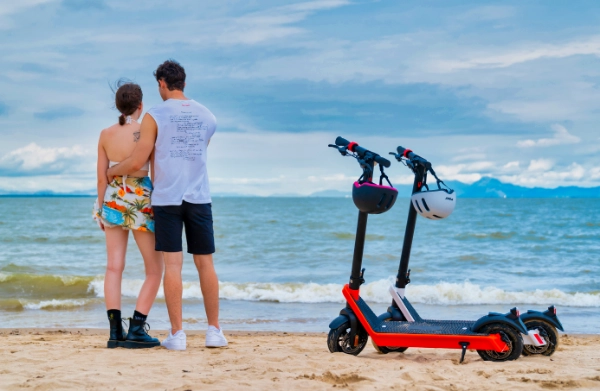Home > ABOUT KIXIN > Blog > How to Charge the Removable Battery of Portable Electric Scooter?
How to Charge the Removable Battery of Portable Electric Scooter?
The advent of e scooter with removable battery offers a convenient and environmentally friendly alternative to traditional transportation. In this blog post, KIXIN will share tips on charging charge the removable battery of portable electric scooter. Properly charging these batteries is essential to preserve battery life and ensure optimal performance.
Understanding Your Battery
Before diving into the charging process, it's essential to understand the type of battery your scooter uses. Most portable electric scooters utilize lithium-ion (Li-ion) or lithium-polymer (LiPo) batteries due to their high energy density and low self-discharge rates. These batteries are characterized by their voltage (V), capacity in ampere-hours (Ah), and the number of cells (S) in series.
1. Voltage (V): This is the electrical potential difference between the terminals of the battery. For Li-ion batteries, a standard cell typically has a nominal voltage of 3.7V.
2. Capacity (Ah): This refers to the amount of electrical energy a battery can store. It is calculated by multiplying the current (in amperes) by the time (in hours) the battery can supply that current.
3. Cells in Series (S): The total voltage of the battery pack is the sum of the voltages of all cells in series. For example, a 3S2P battery has three cells in series and two parallel paths, resulting in a total voltage of 11.1V (3.7V x 3).
Battery Management System (BMS)
The Battery Management System (BMS) is a critical component that ensures the safe and efficient operation of the battery. It monitors parameters such as voltage, current, and temperature, and protects the battery from overcharging, over-discharging, and short-circuiting. When charging, the BMS communicates with the charger to regulate the charging process.

Charging Process
The charging process for a Li-ion or LiPo battery typically involves three stages: constant current (CC), constant voltage (CV), and a final float or topping-off phase.
1. Constant Current (CC) Phase: During this phase, the charger supplies a constant current to the battery. The voltage across the battery increases as the battery fills, but the current remains constant.
2. Constant Voltage (CV) Phase: Once the battery reaches approximately 90-95% of its capacity, the charger switches to CV mode, maintaining a constant voltage while reducing the current. This is the final stage of charging, where the battery is topped off.
3. Float or Topping-Off Phase: After the CV phase, some chargers may enter a float mode, where a small current is supplied to the battery to offset self-discharge.
Charging Equipment
To charge your scooter's removable battery, you will need a compatible charger that is designed for the specific type and specifications of your battery. Look for chargers with the following features:
1. Battery Compatibility: Ensure the charger is compatible with your battery's chemistry (Li-ion or LiPo) and voltage.
2. Automatic Current Regulation: A good charger will automatically adjust the current based on the battery's needs during the charging process.
3. Temperature Monitoring: Some chargers have built-in temperature sensors to prevent overheating, which can damage the battery.
4. Balance Charging: For multi-cell batteries, balance charging ensures that each cell is charged evenly, prolonging the battery's life.

Safety Precautions
Safety is paramount when charging any type of battery. Here are some precautions to follow:
1. Ventilation: Always charge the battery in a well-ventilated area to dissipate heat and prevent the buildup of potentially flammable gases.
2. Avoid Overheating: Never charge the battery in direct sunlight or in an enclosed space where heat can accumulate.
3. Use Original Chargers: Only use chargers that are specifically designed for your battery to prevent damage and potential safety hazards.
4. Inspect the Battery: Regularly inspect the battery for any signs of damage, such as swelling, punctures, or corrosion. Damaged batteries should not be charged.
5. Store Properly: When not in use, store the battery in a cool, dry place away from direct sunlight and heat sources.
Troubleshooting Common Issues
1. Slow Charging: If your battery is charging slowly, check the charger's current setting and ensure it is set to the maximum recommended value for your battery.
2. Battery Not Holding Charge: If your battery is not holding a charge, it may be due to a failing BMS or a battery nearing the end of its life cycle.
3. Overheating: If the battery or charger becomes excessively hot during charging, stop the process immediately and allow both to cool down. Inspect for any signs of damage.
Conclusion
Properly charging the removable battery of a portable electric scooter is crucial for maintaining its performance and longevity. By understanding the charging process, using the right equipment, and following safety precautions, you can ensure that your scooter's battery remains in optimal condition. Always refer to the manufacturer's guidelines for your specific scooter and battery model to ensure the best results.
- Provide repair addressProvide repair address
- WARRANTY1 year full product warranty
- Provide accessoriesAdditional accessories will be provided for
replacement when bulk orders are shipped from China - Online guidanceOnline guidance on how to repair or replace
